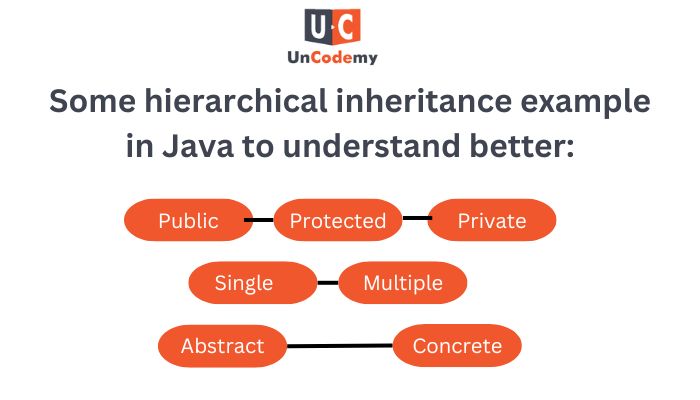What is Hierarchical Inheritance in Java? With Examples

Hierarchical inheritance is a fundamental concept in Java’s object-oriented programming paradigm. It involves creating a class hierarchy in which one class (known as the superclass) can be extended by another class (known as the subclass). The subclass can inherit the methods and properties of the superclass, and can also add its own unique methods and properties. This allows for code reuse and abstraction, as well as the ability to model complex relationships between classes. An example of hierarchical inheritance might be a superclass called “Vehicle”, with subclasses like “Car”, “Truck”, and “Motorcycle”, which all inherit properties like “wheels” and “engine”, but also have unique properties and behaviors, such as “doors” or “horsepower”.
Some Hierarchical Inheritance example in Java to understand better

1. Inheritance can be single or multiple. Single inheritance means a subclass inherits from one superclass, while multiple inheritance means a subclass inherits from multiple superclasses.
2. Inheritance can be public, protected, or private. Public inheritance means that a subclass’s methods and properties can be accessed outside the subclass, while protected inheritance means they can only be accessed within the subclass or any other subclasses that extend the subclass. Private inheritance means that the subclass can inherit from a superclass, but the superclass’s methods and properties cannot be accessed from the subclass or any other classes.
3. Inheritance can also be abstract or concrete. An abstract superclass cannot be instantiated, while a concrete superclass can. A subclass that extends an abstract superclass must implement the abstract methods defined in the superclass.
4. Inheritance in Java is not limited to classes. Interfaces can also be inherited. An interface defines a contract that must be implemented by a class, but does not provide any implementation itself. A class can implement multiple interfaces, which can be useful for creating flexible and reusable code.
Some troubles that might occur in Inheritance program in Java with solutions:

1. Inheritance in Java can lead to some problems if not used carefully. One such problem is called “diamond inheritance,” which occurs when a class inherits from two other classes that both inherit from a common superclass. This can lead to ambiguity in which implementation of a method should be used. To avoid this problem, Java supports the “diamond operator” to specify which implementation to use.
2. Another potential issue with inheritance is the “fragile base class” problem. This occurs when a change to a superclass can have unintended consequences for its subclasses. To avoid this problem, it’s important to carefully design the superclass to be flexible and extensible, and to use inheritance wisely and judiciously.
3. Consider using composition over inheritance. Instead of extending a class to add new functionality, consider creating a new class that contains an instance of the existing class, and adds the new functionality on top of it. This approach can be more flexible and extensible in the long run.
4. Be mindful of the “inheritance depth.” Deep inheritance hierarchies can lead to complex and brittle code. Try to keep the inheritance hierarchy shallow, with only a few levels of classes extending one another.
5. Be careful when overriding methods. If you override a method from a superclass, make sure to follow the “Liskov Substitution Principle,” which states that a subclass should be a suitable replacement for the superclass without changing its behavior or breaking any assumptions about it.
6. Use abstract classes to define common functionality that can be shared among multiple subclasses. Abstract classes cannot be instantiated directly, but can be extended by concrete classes to provide specific implementations.
7. Be aware of the diamond operator and how it works. It can be used to resolve ambiguity in multiple inheritance scenarios, but it’s not a silver bullet and should be used judiciously.
8. Be careful when casting objects between classes in an inheritance hierarchy. Upcasting (casting to a superclass) is generally safe, but downcasting (casting to a subclass) can be dangerous and lead to runtime errors.
9. Be aware of the difference between “is-a” and “has-a” relationships. “Is-a” relationships are used to define subclassing, while “has-a” relationships are used to define composition. Understanding the difference can help you make better decisions about when to use inheritance.
10. Don’t forget about the “prefer composition over inheritance” principle. Composition allows you to create more flexible and reusable code, and can be a better alternative to inheritance in many cases.
11. Be aware of the performance implications of inheritance. Virtual method calls can be slower than non-virtual calls, and deep inheritance hierarchies can lead to slower method resolution times.
12. Avoid unnecessary inheritance. If a class doesn’t need to inherit from another class, don’t make it do so just for the sake of it. Inheritance should be used purposefully and intentionally.
13. Be cautious when creating inheritance cycles. These are situations where class A inherits from class B, which in turn inherits from class A. This can lead to complexity and performance issues, and should generally be avoided.
14. Consider using an interface instead of inheritance. Interfaces provide a way to define a set of behaviors that can be implemented by multiple classes, without requiring them to be part of a class hierarchy. This can be a more flexible and maintainable approach than inheritance.
15. Think about polymorphism and how it relates to inheritance. Polymorphism allows you to treat objects of different types as if they were of the same type, as long as they implement the same interface. This can be a powerful tool for creating flexible and reusable code.
16. Be mindful of the Open-Closed Principle, which states that classes should be open for extension, but closed for modification. This means that you should try to design your classes in a way that allows them to be extended without having to modify the original class.
17. Consider the Single Responsibility Principle, which states that each class should have only one responsibility. This can help to keep classes focused and avoid complexity and confusion.
18. Avoid using inheritance to couple unrelated classes together. If two classes have no meaningful relationship, they probably shouldn’t inherit from each other.
19. Be aware of the performance implications of virtual method calls. Virtual method calls can be slower than non-virtual calls, so if performance is critical, you may want to avoid virtual methods.
20. Use interfaces to define dependencies between classes, rather than inheritance. Interfaces provide a flexible way to define the behaviors that classes must implement, without forcing them to inherit from each other.
21. Be cautious when using “deep” inheritance hierarchies. Having many levels of inheritance can lead to complex and difficult-to-understand code. Try to keep your inheritance hierarchies shallow, with no more than two or three levels.
22. Be cautious when using multiple inheritance. While Java doesn’t allow classes to inherit from multiple classes, you can implement multiple interfaces. However, this can lead to complexity and confusion. Use multiple inheritance sparingly, and only when it truly makes sense.
23. Make sure that subclasses override base class methods only when necessary. Overriding methods for no good reason can lead to confusion and ambiguity.
24. Be careful when using final classes and methods. While final classes can’t be inherited from, and final methods can’t be overridden, they can be useful for defining invariants and preventing unexpected behavior. However, use them sparingly, as they can also reduce flexibility.
25. Beware of the “God class” problem. This occurs when a class tries to do too much and becomes bloated and difficult to understand. Keep classes focused and cohesive, and avoid creating classes that try to do everything.
26. Make sure that subclasses don’t break the contract of their base classes. This means that they should adhere to the same rules and conventions as their base classes, and not do anything that would break the behavior or expectations of the base class.
27. Avoid using inheritance to enforce artificial relationships between classes. Inheritance should only be used when there is a true “is-a” relationship between the classes, not just to group classes together for convenience.
28. Finally, remember that inheritance is not the only way to achieve code reuse and polymorphism. There are other design patterns, such as the Decorator pattern, that can be used to achieve similar results without using inheritance.
29. Be aware of the “Bertrand Meyer” principle, which states that a subclass should not be able to break the contract of its base class. In other words, a subclass should not be able to do anything that would break the expectations of the base class.
Conclusion:1.
Inheritance is a powerful and useful feature of Java, but it should be used with caution and restraint. When used correctly, it can lead to more reusable and maintainable code, as well as more flexible and polymorphic behavior. However, it can also lead to complex and difficult-to-understand code if not used judiciously. The key is to understand when inheritance is the right tool for the job, and to use it in a way that is clear, concise, and well-defined.




























